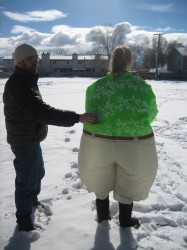The Fat Suit
ACE Alumni
|March 29, 2011
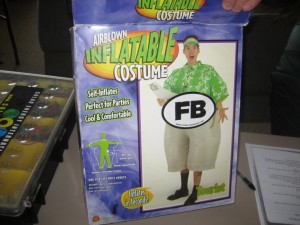
 What does a fat suit have to do with climate change? You’re about to find out.
What does a fat suit have to do with climate change? You’re about to find out.
To kick-start this semester our partner organization Solar Energy International explained this and showed it to us.
The fat suit is a Halloween costume that uses a fan to inflate and make a person nice and round.
During the first Colorado Training of the year Solar Energy International brought out the fat suit to demonstrate that anything that is operated on battery power can be operated with solar energy. Noah Davis coordinator of Solar in the Schools broke it down for us.
“The fat suit is a cheap inflatable Halloween-type costume. Normally the fan that inflates the costume operates on four AA batteries, so it’s a six volt fan. Individual solar cells operate at about half a volt, so we need 12 cells wired together to make 6 volts. It’s that simple.
We wire together two small solar modules with 6 cells in each one, recycle the batteries that we 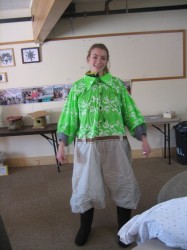 don’t need anymore, and run the whole schlemozzle on the power of light. It looks just as funny (or perhaps even funnier) and creates no emissions whatsoever. On cloudy days we wire more modules together in parallel to increase current while staying at 6 volts. The fat suit is a hit wherever we take it.”
don’t need anymore, and run the whole schlemozzle on the power of light. It looks just as funny (or perhaps even funnier) and creates no emissions whatsoever. On cloudy days we wire more modules together in parallel to increase current while staying at 6 volts. The fat suit is a hit wherever we take it.”
So, lets check out how this suit works!
Noah Continues to explain that its not just the fat suit that can be operated in this way. ” Virtually any battery-operated toy can be powered with solar power instead of batteries. In our teacher trainings and advanced student presentations we convert all kinds of things to solar electricity: remote controlled cars, bubble makers, water pumps, radios, and on and on.” Hands on training is where it is at, whether you are a teacher or a student, it is the best way to learn.
“Hands-on training is where its at with kids. As an example look at our energy bike. We could, if we wanted to, teach the relative wattage of different kinds of light bulbs – incandescent, compact fluorescent, or LED – just by writing a bunch of numbers on the white board. The facts are there, the kids might even write them down, but they won’t necessarily get it.
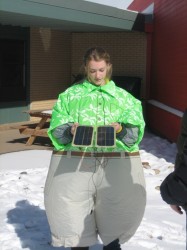 Or we can bring up one volunteer and show them pedaling an energy-generating bicycle to actually make some light. The kid pedals really hard for a couple of minutes to power incandescent bulbs and then the whole class can see them breathing hard from the effort. Then we get that kid to power up some CFL bulbs and it’s easy to see that it’s a breeze, comparatively speaking.
Or we can bring up one volunteer and show them pedaling an energy-generating bicycle to actually make some light. The kid pedals really hard for a couple of minutes to power incandescent bulbs and then the whole class can see them breathing hard from the effort. Then we get that kid to power up some CFL bulbs and it’s easy to see that it’s a breeze, comparatively speaking.
Or, best of all, we can get every kid in the room onto the energy-generating bicycle. Each student can actually feel how hard it is to make energy, to power wasteful bulbs and then feel the incredible difference energy efficiency actually makes. Hands-on is the way to teach energy, and wherever possible that’s what we do at Solar In the Schools.”
So what does a fat suit have to do with climate change? It is a great way to teach about solar energy and show that everyday items can be powered by alternative energy sources instead of fossil fuels.
Join our Youth Action Network
More Blog Posts
Driving India towards self sufficiency and freedom from oil
India can shield itself from oil-price shocks and global pressure over Russian barrels by leaning harder into two strengths it …
Read More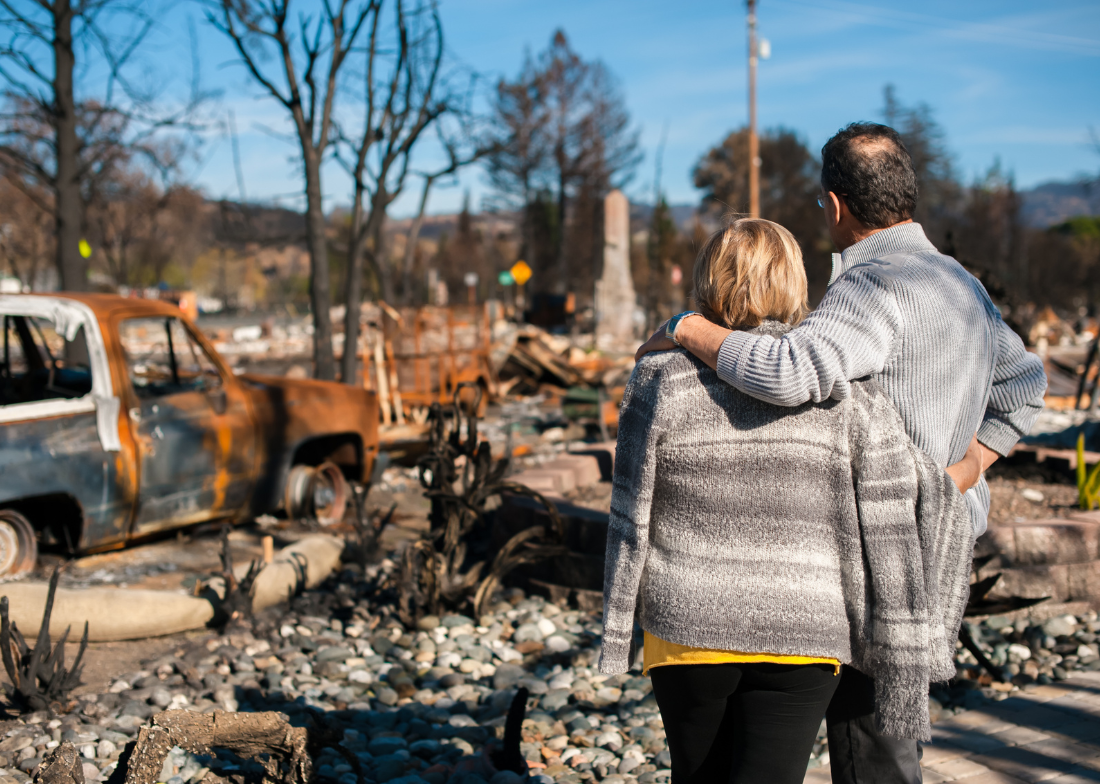
Unnatural, Not Unprecedented
For two weeks, residents of Southern California endured a waking nightmare. Parents raced against time – hurrying down the driveway …
Read MoreCrafting a Vision for the Future: My Experience at LCOY USA 2024
Dry and sunny Tempe, Arizona where temperatures have been over 100 F for 113 consecutive days, delegates gathered to attend …
Read More
